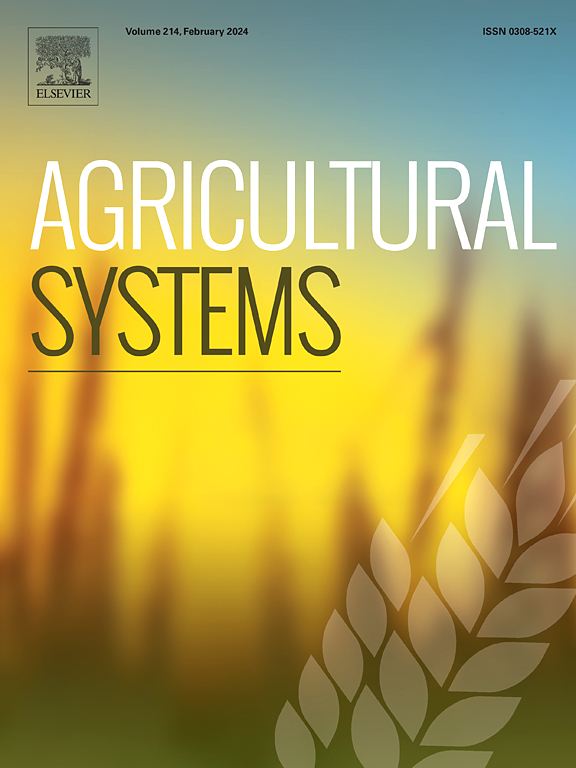Evidence of a rebound effect in agriculture: Crop-livestock reconnection beyond the farm gate does not always lead to more sustainable nitrogen management
IF 6.1
1区 农林科学
Q1 AGRICULTURE, MULTIDISCIPLINARY
引用次数: 0
Abstract
CONTEXT
Reconnecting crop and livestock production beyond the farm gate by exchanging raw materials (e.g., feed, manure) between farms is seen as a promising solution for improving the environmental performance of farms, since it should reduce the use of imported nitrogen (N) inputs. However, such a circular economy does not necessarily lead to a positive outcome, since cooperating farms might simultaneously intensify their production, which could cancel out the benefits of reconnecting crops and livestock: this is known as a rebound effect.
OBJECTIVE
The aim of our study was to identify and analyze a potential rebound effect due to reconnection of crop and livestock farms.
METHODS
We collected data on 18 case-study farms in a small territory in Spain. We then calculated two indicators of the N rebound effect: one based on potential savings of inorganic N fertilizer for cooperating crop farms and another based on potential savings of N losses to the environment for cooperating livestock farms.
RESULTS AND CONCLUSIONS
On cooperating crop farms, importing manure did not lead to replacement of inorganic N fertilizer and could lead more inorganic N fertilizer being used. Thus, their mean N rebound effect was 520 %, which constituted a backfire effect. This mean, however, covered large differences among farms. On cooperating dairy farms, exporting manure resulted in a mean negative rebound effect of −17 %, meaning that they achieved higher savings in the N balance than expected compared to non-cooperating dairy farms.
SIGNIFICANCE
Our main contribution is to show that there may be a rebound effect when reconnecting crop and livestock production beyond the farm gate due to the intensification of farms. The indicators of the N rebound effect developed can thus help identify situations that improve or degrade environmental performance. They should be used to complement existing indicators, such as N-use efficiency and the N balance, to design efficient farming systems while avoiding a rebound effect.

农业反弹效应的证据:农场大门之外的作物-牲畜重新连接并不总能带来更可持续的氮管理
通过在农场之间交换原材料(如饲料、粪便),在农场大门之外重新连接作物和牲畜生产,被认为是改善农场环境绩效的一个很有前景的解决方案,因为这样可以减少进口氮(N)投入的使用。然而,这种循环经济并不一定会带来积极的结果,因为合作农场可能会同时加强生产,这可能会抵消重新连接作物和牲畜所带来的好处:这就是所谓的反弹效应。
本文章由计算机程序翻译,如有差异,请以英文原文为准。
求助全文
约1分钟内获得全文
求助全文
来源期刊

Agricultural Systems
农林科学-农业综合
CiteScore
13.30
自引率
7.60%
发文量
174
审稿时长
30 days
期刊介绍:
Agricultural Systems is an international journal that deals with interactions - among the components of agricultural systems, among hierarchical levels of agricultural systems, between agricultural and other land use systems, and between agricultural systems and their natural, social and economic environments.
The scope includes the development and application of systems analysis methodologies in the following areas:
Systems approaches in the sustainable intensification of agriculture; pathways for sustainable intensification; crop-livestock integration; farm-level resource allocation; quantification of benefits and trade-offs at farm to landscape levels; integrative, participatory and dynamic modelling approaches for qualitative and quantitative assessments of agricultural systems and decision making;
The interactions between agricultural and non-agricultural landscapes; the multiple services of agricultural systems; food security and the environment;
Global change and adaptation science; transformational adaptations as driven by changes in climate, policy, values and attitudes influencing the design of farming systems;
Development and application of farming systems design tools and methods for impact, scenario and case study analysis; managing the complexities of dynamic agricultural systems; innovation systems and multi stakeholder arrangements that support or promote change and (or) inform policy decisions.
 求助内容:
求助内容: 应助结果提醒方式:
应助结果提醒方式:


